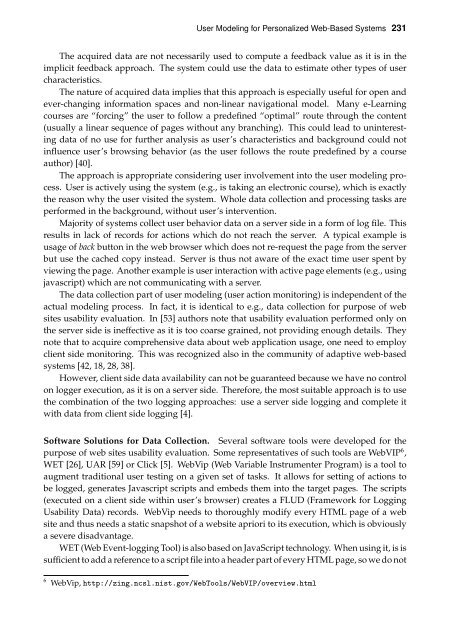elektronická verzia publikácie - FIIT STU - Slovenská technická ...
elektronická verzia publikácie - FIIT STU - Slovenská technická ...
elektronická verzia publikácie - FIIT STU - Slovenská technická ...
You also want an ePaper? Increase the reach of your titles
YUMPU automatically turns print PDFs into web optimized ePapers that Google loves.
User Modeling for Personalized Web-Based Systems 231<br />
The acquired data are not necessarily used to compute a feedback value as it is in the<br />
implicit feedback approach. The system could use the data to estimate other types of user<br />
characteristics.<br />
The nature of acquired data implies that this approach is especially useful for open and<br />
ever-changing information spaces and non-linear navigational model. Many e-Learning<br />
courses are “forcing” the user to follow a predefined “optimal” route through the content<br />
(usually a linear sequence of pages without any branching). This could lead to uninteresting<br />
data of no use for further analysis as user’s characteristics and background could not<br />
influence user’s browsing behavior (as the user follows the route predefined by a course<br />
author) [40].<br />
The approach is appropriate considering user involvement into the user modeling process.<br />
User is actively using the system (e.g., is taking an electronic course), which is exactly<br />
the reason why the user visited the system. Whole data collection and processing tasks are<br />
performed in the background, without user’s intervention.<br />
Majority of systems collect user behavior data on a server side in a form of log file. This<br />
results in lack of records for actions which do not reach the server. A typical example is<br />
usage of back button in the web browser which does not re-request the page from the server<br />
but use the cached copy instead. Server is thus not aware of the exact time user spent by<br />
viewing the page. Another example is user interaction with active page elements (e.g., using<br />
javascript) which are not communicating with a server.<br />
The data collection part of user modeling (user action monitoring) is independent of the<br />
actual modeling process. In fact, it is identical to e.g., data collection for purpose of web<br />
sites usability evaluation. In [53] authors note that usability evaluation performed only on<br />
the server side is ineffective as it is too coarse grained, not providing enough details. They<br />
note that to acquire comprehensive data about web application usage, one need to employ<br />
client side monitoring. This was recognized also in the community of adaptive web-based<br />
systems [42, 18, 28, 38].<br />
However, client side data availability can not be guaranteed because we have no control<br />
on logger execution, as it is on a server side. Therefore, the most suitable approach is to use<br />
the combination of the two logging approaches: use a server side logging and complete it<br />
with data from client side logging [4].<br />
Software Solutions for Data Collection. Several software tools were developed for the<br />
purpose of web sites usability evaluation. Some representatives of such tools are WebVIP 6 ,<br />
WET [26], UAR [59] or Click [5]. WebVip (Web Variable Instrumenter Program) is a tool to<br />
augment traditional user testing on a given set of tasks. It allows for setting of actions to<br />
be logged, generates Javascript scripts and embeds them into the target pages. The scripts<br />
(executed on a client side within user’s browser) creates a FLUD (Framework for Logging<br />
Usability Data) records. WebVip needs to thoroughly modify every HTML page of a web<br />
site and thus needs a static snapshot of a website apriori to its execution, which is obviously<br />
a severe disadvantage.<br />
WET (Web Event-logging Tool) is also based on JavaScript technology. When using it, is is<br />
sufficient to add a reference to a script file into a header part of every HTML page, so we do not<br />
6 WebVip, http://zing.ncsl.nist.gov/WebTools/WebVIP/overview.html

















